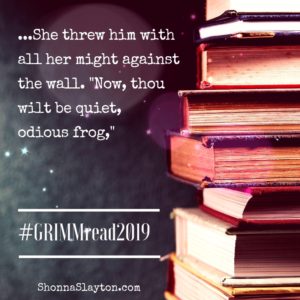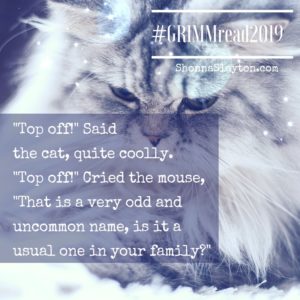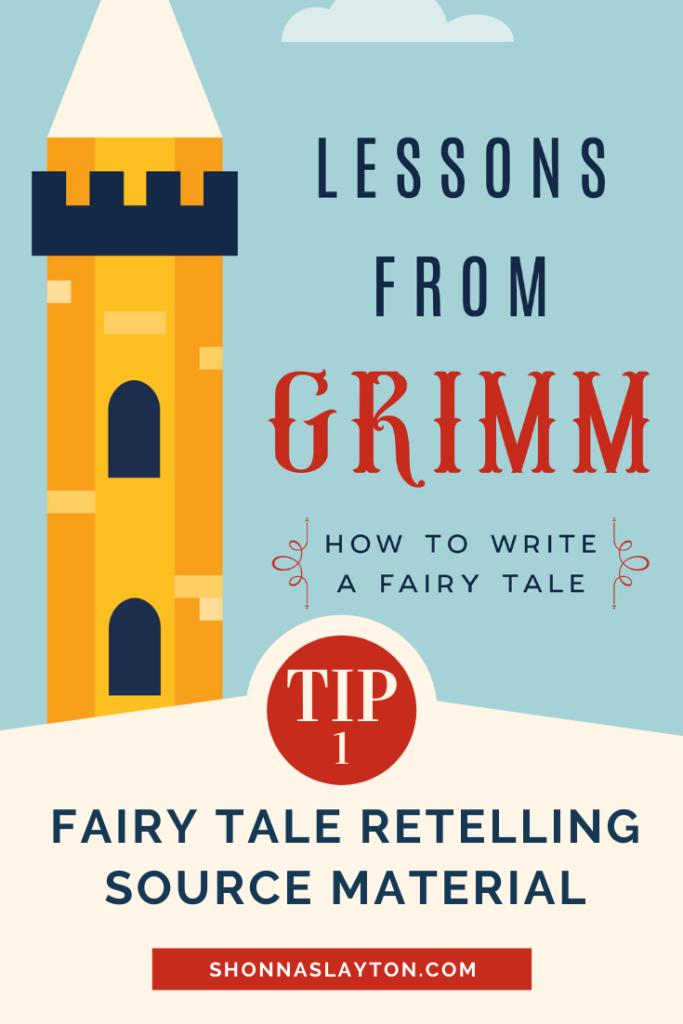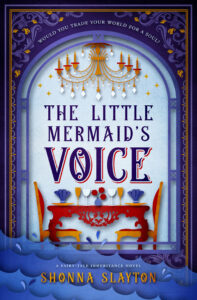Grimm Week 1
Jan 1-5 (Challenge post here: #GRIMMread2019)
1: The Frog King, or Iron Heinrichs
2: Cat and Mouse in Partnership
3: Mary’s Child
4: The Story of the Youth Who Went Forth to Learn What Fear Was
I’m four stories into my year-long Grimm’s Fairy Tales reading challenge, and I’m remembering why I’ve never read through the entire Grimm’s book!
Some of these tales are odd.
And not well fleshed-out.
And it’s making me oh-so-glad for the current trend in fairy tale retellings and adaptations where authors expand on the stories, giving characters clearer motivations and pulling us deeper into a story world.
The Brothers Grimm collected the oral stories from Germany and complied them into their famous collection of tales. So, of course they aren’t novels and are often the bare-bones of a tale. (Almost literally…we’ve got bones in the fourth story of our #GRIMMread2019.)
I naturally read these stories from the perspective of analyzing whether or not they’d make good source material for a retelling. I look for:
- interesting plot
- romantic potential
- type of magic involved
- strong characters
- objects (for my Fairy-tale Inheritance Series)
- unanswered questions (room for my imagination)
These are my thoughts.
The Frog King
In the first story, The Frog King, we read about a self-centered princess who loses her golden ball down a well. She makes a bargain with the talking frog at the bottom, that if he returns the ball to her, he can come live with her. When he gives her the ball, she promptly forgets about him…and worse. But in the end, she frees him from the curse and gains herself a handsome prince.
So…make hasty agreements,
don’t keep your promises,
be mean to someone who helps you…
throw that frog against the wall…
and things will all work out for you?

Or, is the moral with the frog? Persistence pays off?
The story is not terribly romantic. Well, not romantic at all. I don’t know why either Princess or Frog would want to be with each other. This fairy tale could use a major rewrite. At least allow some time for the two protagonists to develop the enemies to lovers trope. Another open-ended part of the tale is why the prince is a frog. Could be that the two characters deserve each other (!)
Of the four stories I read this week, this is the one that sparks my imagination the most for retelling potential. It’s got enough unanswered questions that leave space for variety. My imagination is already poking out in different directions, asking: What if this happened? What if this was the reason?
Yes, I can do something with this story.
Cat and Mouse in Partnership
I’d never read the Cat and Mouse in Partnership before, and found myself wishing the mouse were more clever. Fairy tales tend to favor the innocent and clever, but unfortunately for this mouse, the tale is more of a cautionary one. The mouse in this story gets hoodwinked. Maybe the cat had good intentions and couldn’t overcome his nature. But in the end, it doesn’t matter for the mouse. The cat sneaks food they’ve stored up together for the winter and when the mouse finds out, the cat releases whatever shred of self-control it had left and eats the mouse, too.

How much scope for a retelling is in this story? Hmm. Not the usual young adult novel, anyway. You could make the cat and mouse into people and make it a romance gone bad story. And then for better reader satisfaction, come up with a HEA (happily ever after) ending, complete with a touch of irony for the bad cat.
You could also write about a business partnership gone bad. One partner is embezzling from the other. But again, the ending leaves much to be desired. Or a YA novel involving partnership in a high school robot competition, or something similar.
Betrayal is at the heart of this story. For a retelling, you’d probably want to add another act after the original story ends. So, you’d have not a literal death, but a figurative one before the “mouse” character rallies and comes out victorious in the end.
Mary’s Child
This story was unexpected in a collection of fairy tales. The Mary we’re talking about is Mary, mother of Jesus, but the child we’re talking about is a woodcutter’s daughter. A poor family can’t care for their child, so Mary appears and offers to bring the girl to heaven. Once in heaven, the girl grows up, but fails an honesty test and is brought back to earth to live in the forest. It takes a series of three more tests for the girl to finally admit what she did and be restored.

What interests me about this story is the blend of fairy tale and faith. Granted, there is not much theologically correct about the story—Mary doesn’t literally bring children up to heaven to raise, nor does she test them, etc. These are all imaginative and figurative ideas.
Does using elements of faith work in a fairy tale?
I’m still working this one out in my own writing. It seems easiest to do so in allegory like Pilgrim’s Progress or the Narnia series. Readers know it’s a representation, not the thing itself.
I would like to include more faith points in my stories, but I hold back. How much God-talk is appropriate in a world where fairy-tale magic exists? On what day did God create the fairies?
I probably over-analyze.
My faith is important to me so I’m too cautious, maybe, about blurred lines. Most of my stories take place in the “real” world, not in a generic fairy-tale world. My fairy godmothers tend to act like angels, created beings.
It makes sense that if my fairy godmothers have an angelic-like role, that they would know they were created and be in submission to their creator to fulfil their purpose. And any fairies in rebellion would be like the fallen angels, seeking to create trouble for humans.
Because this is an area I’m trying to figure out myself, a retelling of this story might be a good exercise for me. Maybe a novella? Or a rewrite without Mary in it.
The Story of the Youth Who Went Forth to Learn What Fear Was
Oh boy. Did you read this one?
This story had to have originated with someone’s uncle sitting around a campfire trying to scare the little kids!
It would make a wonderfully creepy Halloween story.
The main part of the story takes place in a haunted castle. Yup, a haunted castle. Not the first thing I think of when I think about fairy tales.
Lots of creepy things happen to the hero, who is quite clueless about what it means to “shudder.”

This story seems like in the right hands it would make a wonderfully, spooky retelling. Those hands are not mine!
But if you’ve got a flashlight handy, turn off the lights, shine it under your chin and tell this story to a bunch of eight-year-old boys and scare them good!
Next week:
Jan 6-12
5: The Wolf and the Seven Young Kids
6: Faithful John or Trusty John
7: The Good Bargain
8: The Wonderful Musician or The Strange Musician
Are you reading along? Comment below and tell me how it’s going.
If you’ve created something in response to the readings, be sure to add your link to below. (Use the specific link so people coming along a month from now can easily find the post.) If you’re linking a blog, you can copy the linky code and paste it into your blog so people can blog hop with ease.
Be sure to visit some of the other links to see what other fairy-tale fans have done. (My daughter and I have been creating quote graphics for Instagram and I’ve set up a group Pinterest board that you can join. I’ll link them below….)





This week I didn’t have time to blog before posting the linky party blog hop (this post.) I didn’t name this post a blog party because I wanted the post to make sense for future visitors. Question for you–is this confusing? Would you rather I keep separate linky party posts and label them as such?
I enjoyed your writing, Shonna. I hadn’t thought of considering the stories from the perspective you take, so you’ve expanded my critical thinking.
Your comments are right on. I admire the scope of your post — I could only find time to give one tale justice. I will comment on at least two next week.
My imagination is still batting around what to make of Iron Henry at the end of the Frog Prince story. Maybe I’ll try my hand at a retelling!
This is an old blog post I made comparing the original “Frog King” to newer adaptations, but I feel like it’s still relevant. http://www.theprincessblog.org/2017/08/the-legacy-of-frog-prince.html
It seems like characters from the original fairy tales were rewarded for being a lot less virtuous than characters in modern adaptations. This is pretty clear in all four of the stories. In “Cat and Mouse,” the cat gets everything he wants despite being a jerk. In “The Frog King,” the princess is nothing but cruel to the frog and gets rewarded with a handsome prince. In “Mary’s Child,” the woman’s life gets saved even though she broke the rules and lied about it so many times that it got ridiculous. In “The Story of the Youth,” you might say that a lot of people were just trying to help the youth with his problem, but one of them ended up falling down the stairs and injuring himself. I think I like the newer versions better because the morals are clearer, and only virtuous characters get rewarded.